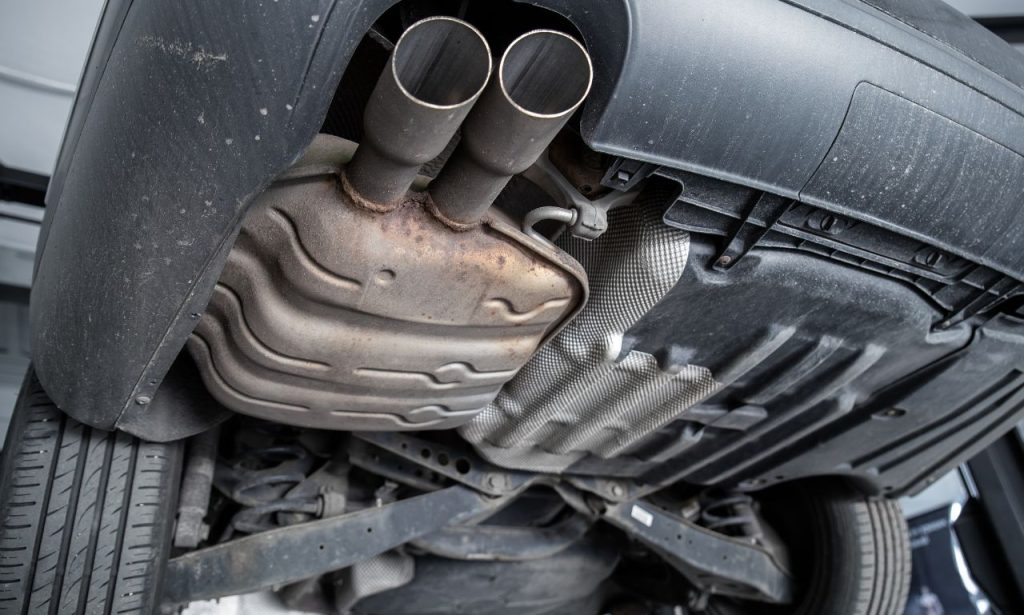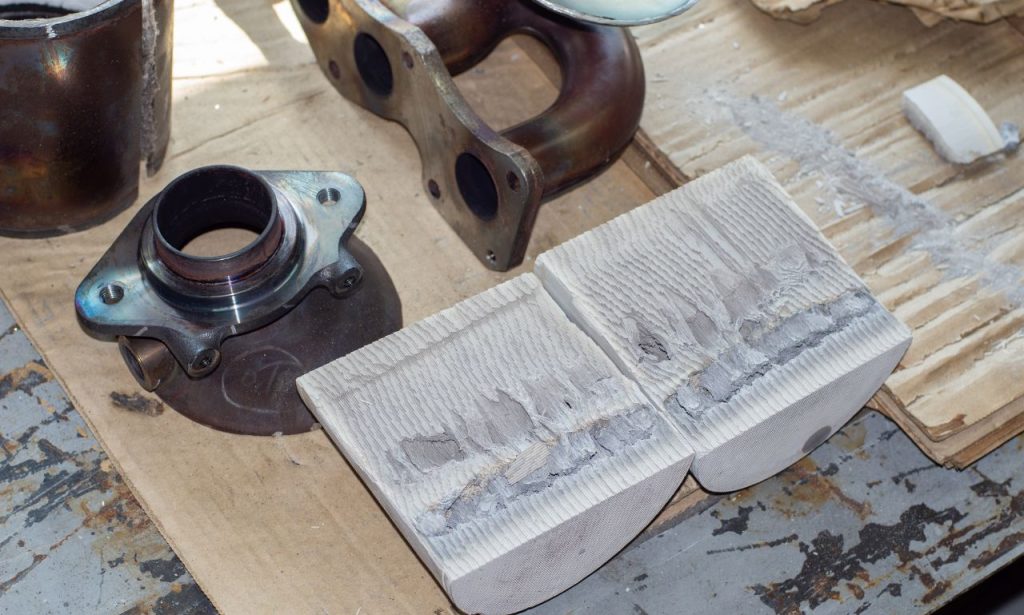You’re cruising down the highway, the open road stretching before you like a ribbon of asphalt. Suddenly, a jarring orange glow on your dashboard steals your attention. The dreaded “Check Engine” light. Your heart sinks. What now? While a myriad of issues could trigger this automotive cry for help, one culprit often lurks silently beneath your car, wreaking havoc on your engine’s performance and your wallet: a failing catalytic converter.
But how does a bad catalytic converter affect your car, you ask? The answer is more complex than you might think, impacting everything from your car’s fuel efficiency to the very air you breathe. This comprehensive guide delves deep into the world of catalytic converters, equipping you with the knowledge to identify, address, and prevent issues before they escalate into costly repairs.
Common Signs of a Bad Catalytic Converter
Your car communicates its health through various signals, and recognizing the common symptoms of a failing catalytic converter can save you from engine damage and ensure a safe driving experience. Here are the telltale signs to watch for:
1. Poor Fuel Economy

Have you noticed frequent trips to the gas station and dwindling gas mileage? A clogged catalytic converter restricts exhaust flow, causing excessive exhaust backpressure. This forces the engine to burn more fuel to maintain power, leading to poor fuel efficiency. The unburned fuel accumulates, and your wallet feels the pinch with each fill-up.
2. Reduced Engine Performance
A healthy engine runs smoothly, but a bad catalytic converter can cause sluggish engine performance. You might experience a lack of power during acceleration, difficulty maintaining high speeds, or engine misfires. The restricted exhaust gases can’t exit efficiently, leading to engine power loss and making uphill drives or overtaking maneuvers challenging.
3. Difficulty Starting the Engine
Starting your car should be effortless. If your engine struggles to start, stalls soon after ignition, or requires multiple attempts, unburnt fuel might be trapped due to a clogged converter. This unburned fuel can foul spark plugs (bad spark plugs or badspark plugs), leading to incomplete combustion and making cold starts problematic.
4. Stalling
Engine stalls and misfires are more than just annoying sounds—they’re signs of deeper issues. A failing catalytic converter can disrupt the air-fuel balance, causing the engine to misfire, especially at idle or low engine speeds. This not only affects performance but can also lead to engine failure if ignored.
5. Illuminated Malfunction Indicator Lamp (MIL)
The dreaded “Check Engine” light can illuminate for numerous reasons. However, when combined with other symptoms like poor fuel economy or reduced power output, it often points to catalytic converter problems. The vehicle’s onboard diagnostic system detects issues through oxygen sensors and exhaust sensors, triggering emissions-related codes.
6. Failed Emission Test
If your vehicle fails an emissions test, the catalytic converter is a prime suspect. Emissions testing measures the levels of harmful gases in your exhaust emissions. A malfunctioning converter can’t effectively reduce toxic gasses like carbon monoxide and nitrogen oxides, resulting in failed tests and potential legal implications.
Consequences of Ignoring a Bad Catalytic Converter

Ignoring the warning signs of a failing catalytic converter isn’t just bad for your car; it’s bad for your wallet and the environment.
1. Damage to Other Exhaust Components
The entire exhaust system works in harmony. A faulty converter affects exhaust flow, causing damage to exhaust manifolds, exhaust downpipes, and mufflers. Exhaust leaks may develop, further impacting engine efficiency and leading to costly repairs at auto repair shops.
2. Potential Risk of Fire
Excessive heat generated by a clogged converter can lead to extreme heat in the exhaust system. This poses a fire risk, endangering the vehicle and occupant safety. Physical damage to the converter’s housing may also occur due to overheating.
3. Legal Implications
Operating a vehicle that doesn’t meet emission requirements is illegal in many jurisdictions. Failing emissions tests can lead to fines, vehicle registration issues, and mandatory repairs. Tampering with or removing the catalytic converter is also illegal, emphasizing the importance of maintaining this component.
4. Increased Harmful Emissions
A failing catalytic converter can’t convert harmful gases effectively, resulting in increased emissions of carbon monoxide, nitrogen oxides, and hydrocarbons. This contributes to air pollution, smog formation, and health hazards, undermining the vehicle’s role as a defense against air pollution.
Importance of Timely Replacement or Repair
Addressing a failing catalytic converter promptly is not just about avoiding inconvenience; it’s about protecting your investment, ensuring your safety, and minimizing your environmental impact.
- Protecting Your Investment: A timely replacement or repair can prevent further damage to your engine and exhaust system, saving you from costly repairs down the road.
- Ensuring Your Safety: Addressing stalling issues and potential fire hazards associated with a failing catalytic converter is crucial for your safety and the safety of others on the road.
- Minimizing Environmental Impact: A properly functioning catalytic converter significantly reduces harmful emissions, contributing to cleaner air and a healthier environment for everyone.
How to Diagnose a Failing Catalytic Converter
Proper diagnosis is crucial. While the symptoms suggest a bad converter, confirmation requires specific diagnostic tools and professional expertise.
1. Visual Inspection
A service professional will examine the converter for signs of physical damage like dents, corrosion, or discoloration. Damage from road debris or fluid leaks (coolant leaks or oil leaks) can impair the converter’s function.
2. Temperature Measurements
Using an infrared thermometer, mechanics compare the temperature at the converter’s inlet and outlet. A significant temperature difference indicates a clog or inefficiency.
3. Backpressure and Vacuum Tests
A pressure gauge measures exhaust backpressure. Excessive pressure suggests exhaust restriction due to a clogged converter. Similarly, a vacuum gauge can assess engine vacuum levels, revealing potential exhaust flow issues.
4. Onboard Diagnostics (OBD-II) Scan
A scan tool reads diagnostic codes from the vehicle’s computer. Codes like P0420 (catalyst efficiency code) indicate catalytic converter efficiency problems. Oxygen sensors upstream and downstream of the converter provide data on exhaust gas levels.
5. Exhaust Emissions Test
Emissions testing can quantify the levels of harmful gases in the exhaust. Elevated readings of carbon monoxide, hydrocarbons, and nitrogen oxides confirm converter malfunction.
How to Replace or Repair a Bad Catalytic Converter

1. Repair vs. Replacement
- Repair: In rare cases, issues like a contaminated converter due to coolant drips (from a head gasket leak) or minor physical damage can be repaired. Catalytic converter cleaners may help dissolve minor clogs, but their effectiveness is limited.
- Replacement: Typically, replacement is the recommended solution. Catalytic converter replacement involves installing a new unit that meets emission requirements. Replacement price varies based on vehicle make and model, converter type, and labor costs.
2. OEM vs. Aftermarket Converters
- OEM Converters: Original Equipment Manufacturer (OEM) converters are designed specifically for your vehicle, ensuring compatibility and compliance.
- Aftermarket Converters: While often less expensive, some aftermarket exhaust components may not meet necessary standards. Ensure any aftermarket catalytic converter is certified and complies with local regulations.
3. Professional Service Recommended
Given the complexity and legal implications, a professional mechanic or dedicated, non-chain exhaust (muffler) shop should perform the replacement. They have the expertise, diagnostic tools, and equipment to handle the exhaust system safely.
DIY vs. Professional Service
While some car enthusiasts might be tempted to tackle catalytic converter replacement themselves, it’s generally not recommended for several reasons:
- Technical Expertise: Replacing a catalytic converter requires specialized tools, knowledge of exhaust systems, and the ability to work safely with potentially hazardous materials.
- Safety Concerns: The exhaust system operates at extremely high temperatures, and working on it without proper precautions can lead to severe burns.
- Legal Requirements: Improper installation or tampering with the catalytic converter can lead to failed emission tests and legal consequences.
It’s best to leave catalytic converter replacement to qualified mechanics who have the expertise, tools, and experience to ensure a safe and effective repair.
Cost Considerations
Understanding the financial and legal aspects is crucial.
1. Cost Factors
- Vehicle Type: Luxury or diesel engines may have higher replacement costs due to specialized parts.
- Converter Type: Converters containing more precious metals cost more but offer better performance and longevity.
- Labor Costs: Labor varies by location and service provider. It’s wise to get estimates from multiple automotive services.
2. Legal Compliance
- Emission Standards: Compliance with the Environmental Protection Agency (EPA) and local regulations is mandatory. Installing a converter that doesn’t meet standards can lead to legal issues.
Documentation: Ensure all repairs and replacements are documented, especially for emissions testing and vehicle inspections.
Legal Requirements and Restrictions
Catalytic converters are subject to strict regulations due to their role in reducing harmful emissions.
- EPA Regulations: The Environmental Protection Agency (EPA) sets standards for catalytic converter efficiency and emissions output. Tampering with or removing a catalytic converter is illegal under federal law.
- State and Local Laws: Individual states and municipalities may have additional regulations regarding catalytic converter replacement, such as requiring the use of OEM (Original Equipment Manufacturer) parts or certified aftermarket options.
It’s crucial to be aware of and comply with all applicable laws and regulations when dealing with catalytic converter replacement to avoid fines, legal issues, and potential harm to the environment.
Tips for Maintaining a Healthy Catalytic Converter
While catalytic converters are designed to last for many years and miles, proper care and maintenance can significantly extend their lifespan and prevent premature failure. Here are some essential tips to keep your catalytic converter in top shape:
1. Regular Vehicle Maintenance
Just like any other component in your car, your catalytic converter benefits from regular maintenance. This includes:
- Regular Oil Changes: Using the correct oil type and adhering to the manufacturer’s recommended oil change intervals ensure your engine runs smoothly, reducing the strain on the catalytic converter.
- Spark Plug Replacement: Worn-out spark plugs can cause misfires, sending unburnt fuel into the exhaust system and damaging the catalytic converter. Replace spark plugs as recommended by your car’s maintenance schedule.
- Air Filter Replacement: A clogged air filter restricts airflow to the engine, disrupting the air-fuel mixture and potentially harming the catalytic converter. Replace your air filter regularly, especially if you frequently drive in dusty or polluted environments.
2. Using Proper Fuel and Fluids

The quality of fuel and fluids you put into your car directly impacts the health of your catalytic converter.
- High-Quality Fuel: Using high-quality fuel with the correct octane rating for your vehicle ensures optimal combustion and reduces the amount of unburnt fuel entering the exhaust system.
- Avoiding Leaded Fuel: Leaded fuel is extremely harmful to catalytic converters and is illegal for use in modern vehicles. Always double-check that you’re using unleaded fuel.
- Proper Fluid Levels: Maintaining proper fluid levels, especially coolant and transmission fluid, prevents overheating and excessive wear and tear on engine components, indirectly benefiting the catalytic converter.
3. Avoiding Excessive Idling or Aggressive Driving
Your driving habits can significantly impact the lifespan of your catalytic converter.
- Minimize Idling: Excessive idling, especially for extended periods, can overheat the catalytic converter and reduce its efficiency. If you’re stopped for more than a few minutes, it’s best to turn off your engine.
- Avoid Aggressive Driving: Rapid acceleration and hard braking put unnecessary strain on the engine and exhaust system, including the catalytic converter. Adopt a smoother driving style to reduce wear and tear and prolong the life of your catalytic converter.
Conclusion
Understanding how a bad catalytic converter affects your car empowers you to recognize the warning signs, take timely action, and prevent costly repairs. By following the maintenance tips outlined in this guide and addressing any potential issues promptly, you can keep your car running smoothly, protect your investment, and contribute to a cleaner environment for everyone. Remember, a little knowledge and proactive care go a long way in ensuring a healthy and happy driving experience.
ALSO READ: Are 10 Year Old Tires Still Good?
FAQs: Addressing Your Catalytic Converter Concerns
While technically possible, driving with a bad catalytic converter is not a good choice. It can lead to further damage to your engine and exhaust system, reduce fuel efficiency, increase emissions, and even be illegal in some areas.
Catalytic converters are designed to last for the average lifespan of a vehicle, typically around 10 years or 100,000 miles. However, factors like driving habits, fuel quality, and regular maintenance can influence their longevity.
While some aftermarket catalytic converters meet or exceed OEM standards, others may not be as durable or efficient. It’s crucial to choose reputable brands and ensure the aftermarket catalytic converter is compliant with your vehicle’s emissions standards.
While some DIY methods claim to clean catalytic converters, their effectiveness is debatable, and they may even damage the delicate internal structure. It’s generally not recommended to attempt cleaning a catalytic converter.
Catalytic converter theft is unfortunately common due to the precious metals they contain. If your catalytic converter is stolen, report the theft to the police immediately and contact your insurance company to file a claim.




